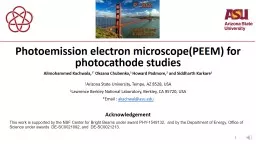

Alimohammed Kachwala 1 Oksana Chubenko 1 Howard Padmore 2 and Siddharth Karkare 1 1 Arizona State University Tempe AZ 8528 USA 2 Lawrence Berkley National Laboratory Berkley CA 95720 USA ID: 932372
Download Presentation The PPT/PDF document "Photoemission electron microscope(PEEM) ..." is the property of its rightful owner. Permission is granted to download and print the materials on this web site for personal, non-commercial use only, and to display it on your personal computer provided you do not modify the materials and that you retain all copyright notices contained in the materials. By downloading content from our website, you accept the terms of this agreement.
Slide1
Photoemission electron microscope(PEEM) for photocathode studiesAlimohammed Kachwala,1* Oksana Chubenko,1 Howard Padmore,2 and Siddharth Karkare11Arizona State University, Tempe, AZ 8528, USA2Lawrence Berkley National Laboratory, Berkley, CA 95720, USA*Email : akachwal@asu.eduAcknowledgementThis work is supported by the NSF Center for Bright Beams under award PHY-1549132, and by the Department of Energy, Office of Science under awards DE-SC0021092, and DE-SC0021213.
1
Slide2IntroductionPhotoemission electron microscopy is regarded as one of the most promising approach to photoemission-based imaging techniques.In PEEM, the sample is illuminated with light (UV-Hg Lamp or LASER) and the electrons emitted from the surface are imaged.The FOCUS-PEEM has been installed at the photoemission and bright beams lab(PBBL) at ASU and will be connected to: Alkali-Antimonide thin film growth ChamberAFM with Capability of Kelvin Probe Microscopy Electron Energy Analyzer Chamber (Which can measure 3D momentum distribution of electrons) 200kV DC electron gun with cryogenically cooled cathodeThe FOCUS-PEEM sample holder is compatible with standard omicron paddle shaped holder which allows for large flexibility in terms of sample size.
Ref. PEEM-Brochure_2017_Rev8
2
Slide3Instrumentational AspectsIS-IEF-PEEM aspectsReal Space ImagingEnergy Filtered Real Space Imagingk-Space Imaging (MTE measurement)Energy Filtered k-Space ImagingAngle of Incidence: 65⁰, 45⁰, 0⁰(top), 0⁰(bottom) to the normal of the sampleExcitation sources available in the labUV Excitation (Hg- Lamp 5.2eV)20W, femtosecond solid state laser with a repetition rate up to 500 kHz (LightConversion PHAROS). The laser output is fed to an optical parametric amplifier (LightConversion ORPHEUS) to provide tunable wavelengths from 200 nm to 2000 nm
Resolution
Real Space: 38.4nm
k-Space: 7.4m
Å
-1
Energy: 62meV
3
Slide4Ongoing ProjectsVariation in Electron EmissionPolycrystalline Molybdenum4
Photonics Integrated Cathodes
Acknowledgement:
Rehan
Kapadia,
Ragib
Ahsan, Hyun
Uk
Chae
Emission from Diamond Tip
Source : Hg Lamp (5.2eV)
Acknowledgement:
Evgenya
I
Simakov
,
Dongsung
Kim
Slide5Possible Future StudiesNano Sources5Ref. Li, R. K., et al. "Surface-plasmon resonance-enhanced multiphoton emission of high-brightness electron beams from a nanostructured copper cathode." Physical review letters 110.7 (2013): 074801.
Work Function Variation
Epitaxial Graphene on
SiC
(0001)
Ref. Mathieu, C., et al. "Recent Advances In 2D‐Band Structure Imaging By k‐PEEM and Prospects For Technological Materials."
AIP Conference Proceedings
. Vol. 1395. No. 1. American Institute of Physics, 2011.
Plasmon Assisted Photoemission
Ref. Durham, Daniel B., et al. "Plasmonic lenses for tunable ultrafast electron emitters at the nanoscale."
Physical Review Applied
12.5 (2019): 054057.